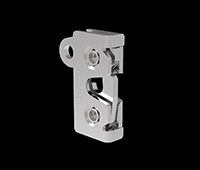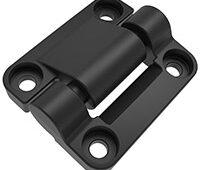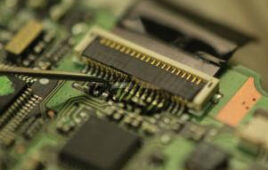Despite the buzz about the IoT and the IIoT, the development of tools and programs for the design of IoT systems and equipment are still embryonic. But there are signs of progress. Here’s what industry leaders are saying about developments in IoT technology.

Computer server room. Technology, internet and network concept
Leslie Langnau, Managing Editor
The Internet of Things (including the Industrial Internet of Things) is:
- A concept—a view that the analysis of tons of gathered data will, if all goes well, help improve manufacturing efficiencies.
- A hope—The use of these analyzed data will enable a company to increase its bottom line in the form of new services, or new performance due to the analysis.
- A perspective—now that we have the tools, the digitization of everything will usher in a new age of optimized systems, and perhaps even systems that adjust themselves to manufacturing needs automatically.
- And sometimes, an actual hardware component—primarily sensors today, but eventually AI enabled or controlled electro-mechanical systems.
It is the task of the design engineer to find ways to develop products that deliver on one or more of the above four views. Despite the buzz that’s been around this industry for several years, though, the development of tools and programs for the design of IoT systems and equipment are still embryonic with sensors and preventive maintenance services being the main offerings. Analytical software is coming, but also still in development as algorithms need to mature.
The most frequently mentioned applications of IoT today are services, especially preventive maintenance services. These services are an improvement over what has been available for a decade or more. Yet they are not ready to deliver on the promise of manufacturing machines evaluating themselves and implementing improvements automatically.
But there are signs of progress. We asked several industry leaders about the developments in IoT technology.
- What hardware trends do you see coming for designers of IoT automation systems?
“One hardware trend we see coming,” says Benson Hougland, vice president, Opto 22, “is edge gateway appliances for automation systems, which facilitate communications and data exchange between OT (operations technology) domains and IT (information technology) domains.”
As Hougland noted, IoT platforms, software, and applications typically do not easily or directly support industrial automation communication protocols such as Modbus/TCP, EtherNet/IP, ProfiNet, or even OPC. These protocols have served the OT world well, but the IoT relies on communication protocols, data formats, and tools more common in the IT world. These communication protocols and so on include, RESTful APIs, JSON, MQTT and Node-RED.
Edge appliances that enable communication will help designers move forward in their IoT designs.
While sensors are an important part of the IoT, communication is just as crucial. Notes Oscar Rojas, CEO, Weintek USA, Inc., Ethernet offers a number of advantages, including “its lower cost, faster speed, higher reliability, and better noise immunity. More PLCs, from basic models to advanced ones, have adopted Ethernet interface as standard equipment, and it can be expected that within the next five years, Ethernet should rise as the standard communication method between HMIs and PLCs.”
But Rojas sees a potential challenge with the IoT involving WiFi. “Real time access to monitoring or controlling management centers is becoming critical to industrial automation. Unfortunately it is not always easy and sometimes it is virtually impossible to install an Ethernet wiring connection between on-site machines and the upstream ERP-level applications and supervisory management center.”
Thus, integration between the operations technology and the intelligence technology still is an issue to the advance of IoT applications.
In addition to edge devices and Ethernet, digitization is the next feature or capability needed for IoT.
“Digitization is a key megatrend impacting industrial companies today,” says Gerald Espy, Product Manager – PLC Business, Schneider Electric. “While there are parts of the industry that have been connecting devices for operational efficiency for years, the benefits of digitization for industries is only now being recognized across the entire industry. The evolution of these technologies has drastically reduced the marginal cost of connectivity, communication, and data analysis leading to greater operational efficiency and overall profitability.”
IIoT-embedded devices will be key hardware components, enabling devices to connect with the other parts on the machine or plant floor, as well as cloud-based digital applications, analytics and services at an enterprise level.
Espy agrees with Hougland that edge control is a critical area of focus for future automation systems, especially for managing the analytics tools to which they’re connected.
“And cyber security will be a must at every level of an implementation,” continued Espy. “A chain is only as strong as its weakest link. Designers will see more encrypting features in firmware, true embedded hardware password protection, and other cyber security features for their design needs.
Physical security will also be a must. “With the availability of connected systems, a natural extension is an intelligent physical security device to provide remote control and monitoring of access to equipment and restricted areas,” says Steve Spatig, general manager, Electronic Access Solutions, Southco, Inc. “These smart locking devices can then be controlled and monitored remotely with a cloud based control system. Data collected can provide forensics for security or safety breaches and provide simplified control and distribution of access credentials.”
Digitization is a key megatrend impacting industrial companies today. While there are parts of the industry that have been connecting devices for operational efficiency for years, the benefits of digitization for industries is only now being recognized across the entire industry.
- What are the software trends for automation systems?
“The most obvious software trend is data analytics,” says Arun Sinha, Director of Business Development, Opto 22. “The promise of the IoT includes things like preventive maintenance and prescriptive algorithms, which are achievable through data science and analytics. The good news is that the designers of automation systems don’t need to become data scientists. Many IT companies large and small are developing IoT platforms with sophisticated analytics engines. Examples include IBM Bluemix, Microsoft Azure, and Hitachi Lumada. Some now are even putting a strong focus in their portfolio on specific solutions for manufacturing intelligence. Designers of automation systems should probably familiarize themselves with these platforms’ capabilities, but focus their design efforts on embedding the communication methods and data formats that these platforms require.”
“We see a shift toward more user-centric software, rather than machine-centric,” says Espy. Open and hardware-agnostic software enables manufacturers to give customers access to a full spectrum of industrial applications and services to address their own unique areas of operational efficiency improvement, no matter what devices are installed in their automation system. Putting this power in the customer’s hands allows them to get the right applications for the specific configuration and installation of their operations when they need it most. Of course, software services and 24/7 support should always be included to support the customer when needed.
Schneider Electric sees opportunities coming in the form of augmented reality and transparent cloud-based connectivity for operators. “Mobile devices empowers operators to increase productivity,” continues Espy. Tighter integration between management and what is happening on the plant floor through a suite of enterprise level applications enables more agile and accurate management decisions.
Spatig agrees, noting that cloud based solutions with web portal administration versus on premise software installation and maintenance provides a cleaner user interface, without the need for software maintenance and revision control.
Cyber security will be a must at every level of an implementation. Designers will see more encrypting features in firmware, true embedded hardware password protection, and other cyber security features for their design needs.
- What new “products” do you see coming as a result of designing IoT capability into automation components, systems, and equipment?
The IoT is a concept that somehow must be rendered into useful products. One key to developing such products will revolve around a business’s end-goal, such as cut downtime, improve quality, or increase security, or increase profits. Products will range from simple, single-purpose to sophisticated systems.
One example of simpler IoT products involves security. “Innovative smart locking solutions will be enabled as a result of the connected facilities,” says Spatig. “Physical security will be enhanced and simplified to bring remote access control and management down to the equipment level – something previously only practical at the architectural, building level.
More complex products will not necessarily fit COTS approaches, however.
“IoT applications in end-user locations such as manufacturing facilities and process plants are different from one to the next,” explains Hougland, “so the concept of a turnkey or COTS ‘product’ from designing IoT capability into automation systems may not be common in the marketplace. Instead, the “product” may take the form of a goal or desired outcome, such as decreasing downtime, increasing efficiencies, or improving quality. The common thread is that these desired outcomes usually start with a business goal, like increasing profits.”
Initially, many OEMs are exploring the “increase profits” goal by developing products that are services. “For example, a compressor manufacturer may not charge for the equipment, but rather for the CFM (cubic feet per minute) delivered by their machine,” adds Hougland. The remote monitoring made possible by IoT capability built into the automation system on machines usually through an edge gateway appliance enables such services.
Another forecasted product will be “smart” machines, machines capable of reacting to a change in the market automatically and adjusting accordingly, without supervision.
“These new smart machines are better connected, more flexible, more efficient, and safer than traditional equipment,” says Mark Duncan, segment manager, material handling, Schneider Electric. “They can quickly respond to new demands and participate in preventative maintenance, all while minimizing their environmental footprint and total cost of ownership.”
These smart machines will be self-aware thanks to wired and wireless sensors with embedded intelligence that monitor the components of the machine to avoid component failures and the associated downtime. The information gathered by these machines will also be distributed locally or to a remote cloud, automating decision making on the factory floor.
One key to developing IIoT products will revolve around a business’s end-goal, such as cut downtime, improve quality, or increase security, or increase profits. Products will range from simple, single-purpose to sophisticated systems.
“These machines must also be safe and cyber secure with embedded products like safety PLCs, light curtains, and safety cameras to keep the users and machine safe from harm,” continues Duncan. “With direct connection to the broader Ethernet-based network, the IIoT-embedded devices should have strong communication capabilities, as well as cyber security certifications like Achilles Level II. Finally, by leveraging the wireless network that these smart machines are connected to, operators can use their mobile devices to control machines and processes while moving around the plant floor. Soon, these operators will be able to use augmented reality and artificial intelligence to accomplish these same tasks in real time.”
Opto 22
www.opto22.com
Schneider Electric
www.schneider-electric.com
Southco
www.southco.com
Weintek
www.weintek.com
Filed Under: IoT • IIoT • Internet of things • Industry 4.0, Collars • locking devices, FASTENING • JOINING • locks • latches • pins




